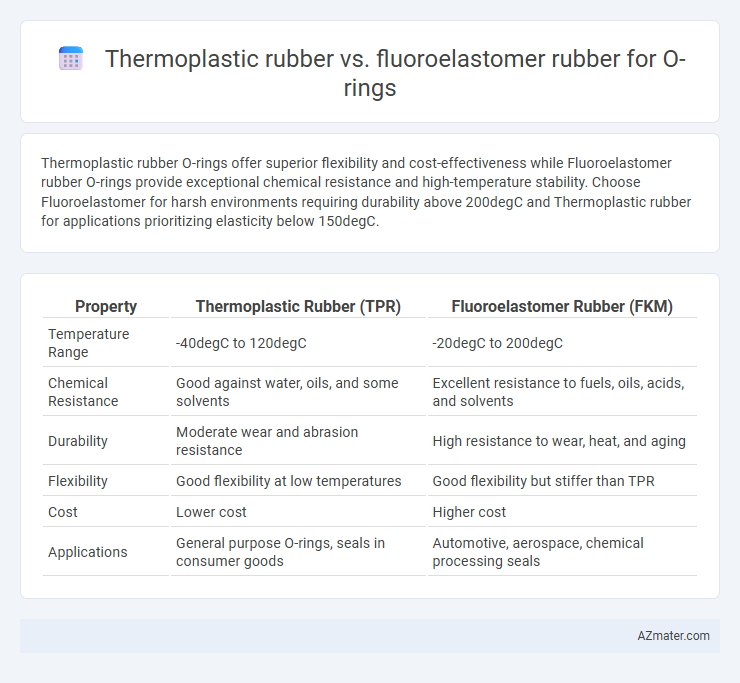Thermoplastic rubber O-rings offer superior flexibility and cost-effectiveness while Fluoroelastomer rubber O-rings provide exceptional chemical resistance and high-temperature stability. Choose Fluoroelastomer for harsh environments requiring durability above 200degC and Thermoplastic rubber for applications prioritizing elasticity below 150degC.
Table of Comparison
| Property | Thermoplastic Rubber (TPR) | Fluoroelastomer Rubber (FKM) |
|---|---|---|
| Temperature Range | -40degC to 120degC | -20degC to 200degC |
| Chemical Resistance | Good against water, oils, and some solvents | Excellent resistance to fuels, oils, acids, and solvents |
| Durability | Moderate wear and abrasion resistance | High resistance to wear, heat, and aging |
| Flexibility | Good flexibility at low temperatures | Good flexibility but stiffer than TPR |
| Cost | Lower cost | Higher cost |
| Applications | General purpose O-rings, seals in consumer goods | Automotive, aerospace, chemical processing seals |
Introduction to Thermoplastic Rubber and Fluoroelastomer Rubber
Thermoplastic rubber (TPR) combines the characteristics of both rubber and thermoplastics, offering excellent flexibility, durability, and ease of processing, making it suitable for various sealing applications including O-rings. Fluoroelastomer rubber (FKM) exhibits exceptional chemical resistance, high-temperature tolerance up to 200degC, and superior resistance to oils, fuels, and solvents, making it ideal for demanding O-ring environments. Choosing between TPR and FKM for O-rings depends on application requirements such as temperature range, chemical exposure, and mechanical performance.
Material Composition and Structure
Thermoplastic rubber (TPR) O-rings consist of a blend of thermoplastic and elastomeric materials, combining the flexibility of rubber with the processability of plastics, typically featuring a block copolymer structure. Fluoroelastomer (FKM) O-rings are composed of fluorinated synthetic rubbers with a cross-linked polymer structure, providing superior chemical resistance and thermal stability due to the strong carbon-fluorine bonds. The thermoplastic nature of TPR allows for easy molding and reprocessing, while the chemically inert and heat-resistant structure of fluoroelastomers makes them ideal for demanding sealing applications in harsh environments.
Key Physical Properties Comparison
Thermoplastic rubber O-rings offer high flexibility, excellent abrasion resistance, and moderate temperature tolerance typically ranging from -50degC to 120degC, making them suitable for dynamic sealing applications. Fluoroelastomer rubber O-rings exhibit superior chemical resistance, outstanding heat resistance up to 200degC or higher, and low gas permeability, ensuring durability in aggressive environments involving fuels, oils, and solvents. The choice between thermoplastic rubber and fluoroelastomer O-rings depends on application temperature, chemical exposure, and mechanical stress requirements.
Chemical and Temperature Resistance
Thermoplastic rubber (TPR) offers moderate chemical resistance and operational temperature ranges typically between -40degC to 120degC, making it suitable for applications with mild chemicals and consistent temperatures. Fluoroelastomer (FKM) rubber exhibits superior chemical resistance against fuels, oils, and aggressive solvents, with a wider temperature tolerance from -26degC up to 200degC or higher, providing enhanced durability for harsh chemical environments and high-temperature applications. Selecting FKM O-rings is critical in industries requiring resistance to extreme chemicals and sustained elevated temperatures, whereas TPR O-rings fit well where moderate chemical exposure and temperature stability are sufficient.
Performance in Sealing Applications
Thermoplastic rubber (TPR) offers excellent flexibility and abrasion resistance, making it suitable for dynamic O-ring sealing applications with moderate chemical exposure and temperature ranges up to 120degC. Fluoroelastomer rubber (FKM) provides superior chemical resistance, thermal stability up to 200degC, and outstanding resistance to oils, fuels, and aggressive chemicals, ensuring enhanced sealing performance in harsh industrial environments. For high-performance sealing under extreme temperature and chemical conditions, fluoroelastomer O-rings outperform thermoplastic rubber counterparts in durability and leak prevention.
Durability and Longevity of O-Rings
Fluoroelastomer O-rings exhibit superior durability and longevity compared to thermoplastic rubber, with resistance to extreme temperatures ranging from -40degC to 200degC and exceptional chemical resistance to oils, fuels, and solvents. Thermoplastic rubber O-rings generally perform well in moderate temperature environments but may degrade faster under chemical exposure and high-temperature cycling. The enhanced resilience of fluoroelastomer ensures extended service life in demanding applications such as automotive fuel systems and aerospace sealing solutions.
Cost Analysis and Value Proposition
Thermoplastic rubber (TPR) O-rings generally offer a lower cost option due to their ease of manufacturing and recyclability, making them suitable for applications with moderate chemical exposure and temperature ranges up to 120degC. Fluoroelastomer (FKM) O-rings, while more expensive upfront, provide superior chemical resistance, temperature tolerance up to 200degC, and longevity in harsh environments, delivering better long-term value in critical sealing applications. The value proposition hinges on balancing initial material cost against durability and performance requirements, with FKM favored when long-term reliability and exposure to aggressive chemicals justify the higher investment.
Common Industries and Use Cases
Thermoplastic rubber (TPR) O-rings are widely used in automotive, consumer goods, and packaging industries due to their flexibility, ease of fabrication, and cost-effectiveness in dynamic sealing applications. Fluoroelastomer (FKM) O-rings excel in aerospace, chemical processing, and oil and gas sectors, offering superior resistance to high temperatures, aggressive chemicals, and fuels. The choice between TPR and FKM O-rings depends on specific operational environments where TPR suits moderate conditions and FKM performs reliably in extreme heat and chemical exposure.
Maintenance and Replacement Considerations
Thermoplastic rubber O-rings offer easier maintenance due to their superior flexibility and resistance to wear, making them ideal for applications with frequent disassembly. Fluoroelastomer rubber O-rings excel in chemical and temperature resistance, resulting in longer service life but necessitating careful inspection to detect signs of degradation before replacement. Selecting between these materials depends on balancing routine maintenance frequency against the operational environment's exposure to heat, chemicals, and mechanical stress.
Choosing the Right Rubber for Your O-Ring Application
Thermoplastic rubber (TPR) offers excellent flexibility and ease of processing, making it ideal for applications requiring moderate chemical resistance and frequent compression cycles. Fluoroelastomer rubber (FKM), known for its superior resistance to high temperatures, aggressive chemicals, and fuels, is the preferred choice for O-rings in harsh industrial environments such as automotive and aerospace. Selecting the right rubber depends on factors like operating temperature range, chemical exposure, and mechanical stress to ensure optimal performance and longevity of the O-ring seal.

Infographic: Thermoplastic rubber vs Fluoroelastomer rubber for O-ring
 azmater.com
azmater.com